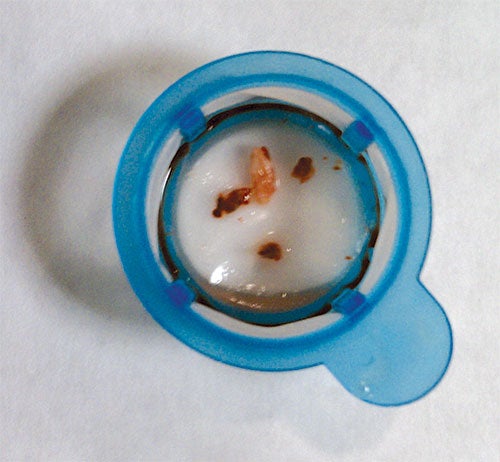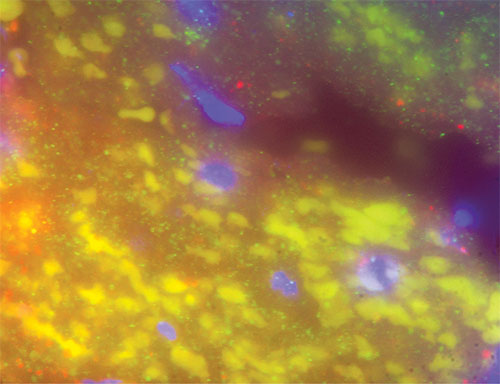discover
Targeting a Heart Attack Gene
 Blood clots removed from a patient who had suffered a heart attack.
Blood clots removed from a patient who had suffered a heart attack. photo: Courtesy of the Journal of Clinical Investigation
Yellow staining represents MRP-14 in platelets in a blood clot.
photo: Courtesy of the Journal of Clinical Investigation
Yellow staining represents MRP-14 in platelets in a blood clot.Researchers at Case Western Reserve School of Medicine and University Hospitals Case Medical Center have discovered a previously unknown culprit in the formation of blood clots—a finding that promises to support novel ways of predicting, treating and preventing heart attacks. Investigators led by the School of Medicine's Daniel I. Simon, MD, are working to target this "heart attack gene"—called myeloid-related protein-14, or MRP-14 for short—to block it from contributing to blood clots that can cause heart attacks.
"We have recently shown that MRP-14 is not only predictive of heart attacks, but also plays a causal role in the chain of events leading to it," said Simon, the Herman K. Hellerstein Professor of Cardiovascular Research and director of UH Harrington Heart & Vascular Institute. "These findings raise the notion that MRP-14 might be a useful target for therapies to prevent heart attacks."
Simon and his colleagues have relied on research in both humans and mice to show how MRP-14 can trigger dangerous clots that trigger heart attacks, as well as strokes, in a previously unsuspected way.
Studies moved back and forth from heart attack patients to laboratories where investigations in mice helped decipher how MRP-14 worked inside the body.
"This body of research provides a terrific example of truly 'translational' research, spanning a full circle from heart attack patients through basic laboratory studies and back to patients," said Peter Libby, MD, a Harvard Medical School professor and chief of the division of cardiovascular medicine at Brigham and Women's Hospital, who mentored Simon early in his career. Libby was involved in related, earlier studies with Simon, but was not involved in this most recent research.
The research results appeared in the May issue of The Journal of Clinical Investigation. With this new insight, Simon and his team hope to develop a therapy that would prevent or shut down heart attacks by subverting MRP-14's natural functioning. Such an approach is particularly promising because MRP-14 increases the amount of clotting, but does not affect the body's natural, immediate response to stop bleeding.
"The new therapy could be the elusive brass ring of cardiac care," Simon said, because it "would reduce the possibility of clotting without increasing the risk for internal bleeding, which is a dreaded complication of existing therapies and can be life-threatening for some patients."
Simon emphasizes that these MRP-14-related discoveries depend on the teamwork of expert partners ranging from biotech-industry veterans to basic scientists. "This project is emblematic of today's highly collaborative science," he said.
—TAMAR NORDENBERG






